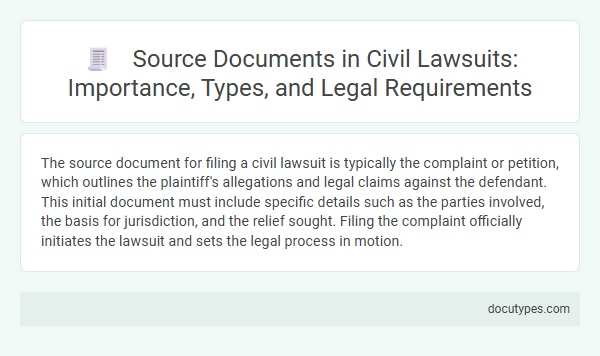The source document for filing a civil lawsuit is typically the complaint or petition, which outlines the plaintiff's allegations and legal claims against the defendant. This initial document must include specific details such as the parties involved, the basis for jurisdiction, and the relief sought. Filing the complaint officially initiates the lawsuit and sets the legal process in motion.
Introduction to Source Documents in Civil Lawsuits
Source documents serve as the foundational evidence for initiating a civil lawsuit. These documents contain relevant facts and details that support the plaintiff's claims.
The primary source document for filing a civil lawsuit is the complaint or petition. This legal document outlines the plaintiff's allegations, legal basis, and the relief sought from the court. It must comply with jurisdiction-specific rules to be considered valid and admissible.
Defining Source Documents in Legal Contexts
Source documents in legal contexts refer to the original records or evidence that initiate and support the filing of a civil lawsuit. These documents provide the factual foundation necessary to present a claim or defense in court.
Examples of source documents include contracts, correspondence, invoices, and official notices relevant to the dispute. Your ability to submit accurate and well-organized source documents is crucial for the success of your case.
Importance of Source Documents in Civil Proceedings
The source document for filing a civil lawsuit is typically the complaint or petition, which outlines the plaintiff's claims and the legal basis for the case. This document is crucial as it initiates the judicial process and formally notifies the defendant of the allegations. Accurate and detailed source documents ensure proper case handling and uphold the integrity of civil proceedings.
Primary Types of Source Documents in Civil Lawsuits
The source document for filing a civil lawsuit serves as the initial legal paper that officially starts a case in court. This document outlines the plaintiff's claims and the nature of the dispute.
- Complaint or Petition - This is the primary source document that details the plaintiff's allegations and the legal basis for the lawsuit.
- Summons - A legal notice issued to the defendant, informing them of the lawsuit and requiring their response.
- Affidavit of Service - A sworn statement confirming that the defendant has been formally served with the lawsuit documents.
Legal Requirements for Validating Source Documents
What is the source document for filing a civil lawsuit? The source document is typically the complaint or petition that initiates the lawsuit. Legal requirements for validating source documents include authenticity, proper formatting, and adherence to jurisdictional rules.
What are the key legal requirements for validating source documents in civil lawsuits? Source documents must be signed by the plaintiff or their attorney, include a clear statement of facts, and comply with court procedural rules. Verification or notarization may be required to ensure validity in many jurisdictions.
Admissibility Standards for Source Documents in Court
The source document for filing a civil lawsuit is typically the original or a certified copy of the complaint or petition outlining the plaintiff's claims. Courts require these documents to adhere to strict admissibility standards to ensure authenticity and relevance.
Admissibility standards demand that source documents be properly authenticated, often through notarization or sworn affidavits, to be accepted as evidence. Your submission must clearly demonstrate the document's validity to withstand challenges during litigation.
Role of Source Documents in Evidence Presentation
Source documents are critical when filing a civil lawsuit as they provide the foundational evidence needed to support your claims. These documents establish the facts and verify the legitimacy of the case in court.
- Authentication of Evidence - Source documents serve to authenticate facts, ensuring the evidence presented is credible and admissible.
- Clarification of Claims - They offer clear, tangible proof that helps clarify and substantiate the legal claims made.
- Foundation for Legal Arguments - Source documents provide the necessary basis for constructing strong, persuasive legal arguments.
Proper use of source documents significantly enhances the effectiveness of evidence presentation in civil litigation.
Common Challenges with Source Document Authentication
The source document for filing a civil lawsuit typically includes contracts, agreements, or written evidence that supports the legal claim. Proper authentication of these documents is critical to ensure they are admissible in court and accurately represent the facts.
- Verification of Authenticity - Confirming the document's origin and legitimacy can be difficult due to potential forgery or alterations.
- Chain of Custody Issues - Maintaining an unbroken and documented custody trail is essential to prove the document has not been tampered with.
- Compliance with Legal Standards - The document must meet jurisdiction-specific criteria for admissibility, which can be complex and vary widely.
Best Practices for Handling and Preserving Source Documents
| Aspect | Details |
|---|---|
| Source Document Definition | The source document for filing a civil lawsuit is the original written or electronic record that forms the basis of the legal claim, such as contracts, agreements, correspondence, or official notices. |
| Examples of Source Documents | Contracts, promissory notes, emails, invoices, receipts, medical records, police reports, affidavits, and formal demand letters. |
| Importance in Civil Litigation | Source documents establish factual grounds, support legal arguments, and serve as critical evidence during discovery and trial stages. |
| Best Practices for Handling |
|
| Best Practices for Preservation |
|
| Legal Compliance | Adhere to jurisdictional rules for evidence handling, retention periods, and privacy regulations regarding sensitive information. |
What Is the Source Document for Filing a Civil Lawsuit? Infographic

